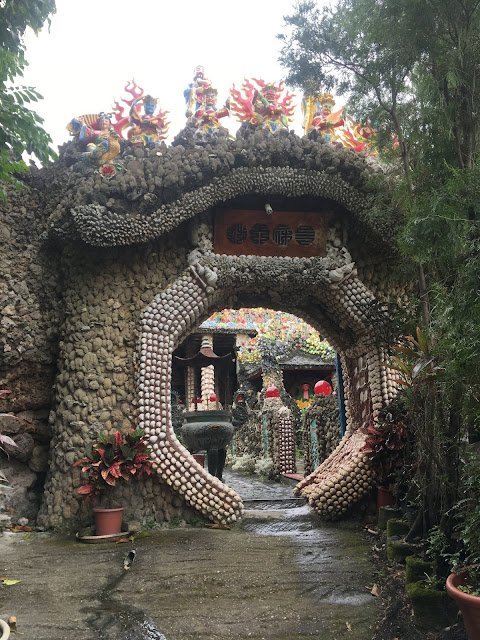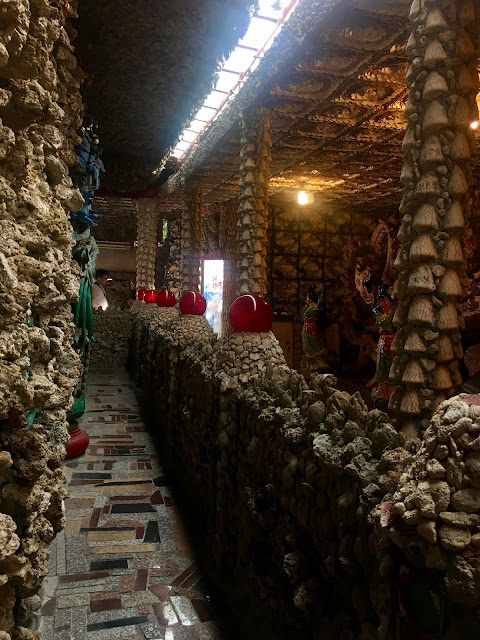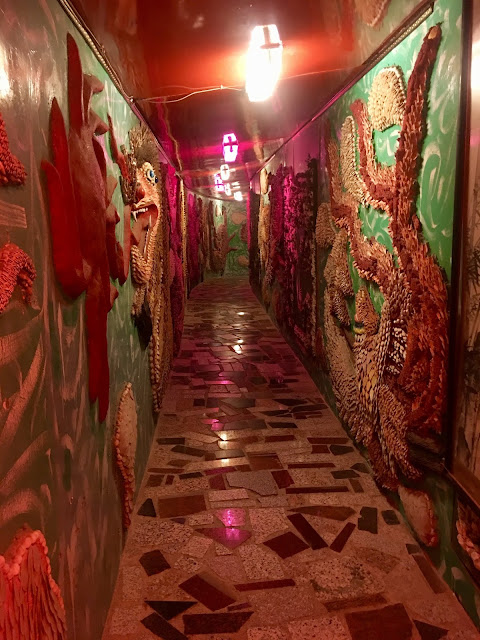Never post about Shell Temple in Changhua: HERE
Finally, after nearly half a year, I was able to meet my Polish friend again. They had just left New Taipei and moved back to Changhua. We had been to Changhua a few times in the past, but we had never visited this unique place. This shell temple is less well-known than the one in the Taipei area, Fufudingshan Shell Temple. The temple may not be big, but it is definitely worth visiting. My friend mentioned this place before but couldn't remember the name. Luckily, I was able to find it quickly. Usually, I search on Google Maps to find interesting places to visit. However, it takes a lot of time, especially when searching for information in Chinese with my very poor language skills (almost non-existent). Thankfully, there are plenty of translators that I can use.
This temple is located in a field, not far from another attraction, Glass Mazu Temple. There is also an underground tunnel where you can see many shell decorations such as dragons and chickens. At the end of the tunnel, there is a shop selling shells and decorations, as well as several aquariums and ponds with fishes and turtles, and even some special birds.
I still wanted to visit Lukang Town, but it was already getting late, and we needed to return to Tainan.
Sanqing Sanyuan Palace Shell Temple (三清三元宫贝壳庙)
Sanqing Sanyuan Palace Shell Temple was built by Huang Qichun, who was born into a poor family. He attended school in the countryside for one year but dropped out at the age of 12 to work as a laborer. At 16, he became an apprentice in an ironworks and learned the skill of making kitchen knives. After retiring, he attempted to start a business but was unsuccessful. In the 1970s, he bought land near Xiu'an Cemetery in Funan Village to build tropical fish ponds. Despite friends advising him against it, he and his wife, Huang Lixiao, proceeded with the plan.
Huang Qichun often dreamed of spiritual phenomena after moving to this place. He dreamt of a stone-covered temple adorned with shells and similar decorations. Inspired by these dreams, he collected various shells and purchased sandstone from Hengchun Town to build the temple. Initially, the coral and shells were fixed with wire, and then cement was gradually applied between the layers. The walls, except for the pillars, roofs, and entrance gates, were all handmade and decorated with shells. The villagers found Huang Qichun and his temple peculiar, leading them to refer to it as the "shell temple." As Huang Qichun's son grew older, he also helped with farming, allowing his father more time to focus on building the temple, which was eventually completed.
The temple has a square shape with a roof adorned with dragons and phoenixes. The space is divided into the front door, main temple, Dragon Palace tunnel, tropical fish farm, and art area. On the walls of the gallery leading to the basement, shells are crafted into the shape of dragons and phoenixes. Due to the land being a farmland, it was impossible to obtain temple registration.
The temple's construction, which took 21 years, was roughly completed in 1996, with the final touches done in late January 1997. By 2001, the temple had gained fame in the district, and many tour buses began bringing visitors to this place. However, the narrow entrance and exit of the parking lot often posed a problem for large tour buses.
Huang Qichun didn't give up his fish farming work and his fishing rod can still be seen beside the temple. To showcase the art of shell creations, the temple features various shells used to create a model temple of Lugang Tianhou Palace. Inside the temple, there is a dragon-shaped decoration called the "Millennium Shell Dragon," which stands 2 meters tall and stretches 3 meters in length, symbolizing the Millennium Year of the Dragon. Huang Qichun's son, Huang Donghui, imported scallops, seaweed, reefs, and other materials from Japan and the Philippines. He transformed them into small decorative boxes using a similar technique and sold them in the basement of the temple.
See also: Fufudingshan Shell Temple
See also: Glass Mazu Temple

























0 komentarze:
Post a Comment